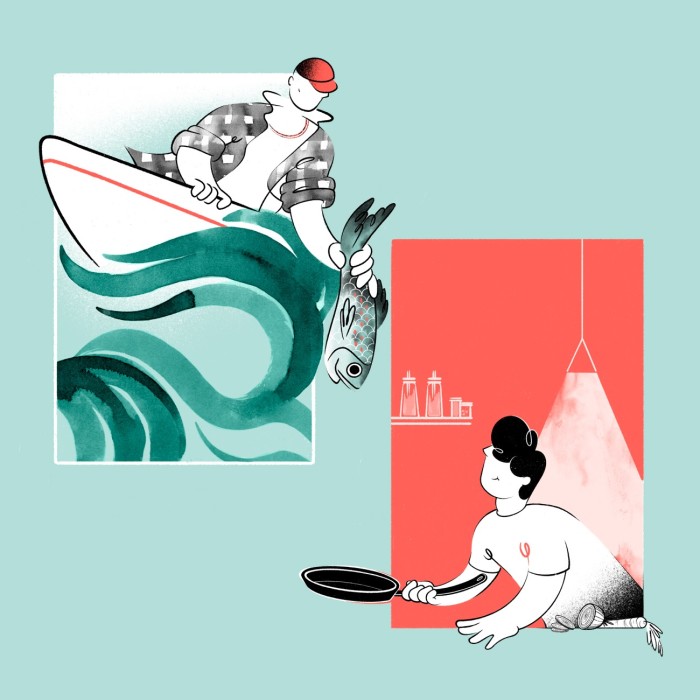Escape Special: fish straight off the boat

Roula Khalaf, Editor of the FT, selects her favourite stories in this weekly newsletter.
Mackerel and live lobster to your door less than 24 hours out of the water. Sea urchin hand-dived off the coast of Devon and in your hands the next morning. That’s the innovation of Pesky Fish, a marketplace and transit business that delivers next-day catch from small independent fishermen to leading restaurants (Ikoyi, Noble Rot, Brat), fishmongers (Notting Hill Fish Shop, Steve Hatt) and now to households across the UK.
Co-founder Ben King started the company three years ago in the hope of rebuilding the seafood supply chain, where fish might pass through three or four hands – from portside auctions to traders at Billingsgate to yet more merchants – before reaching a restaurant. That leads to days-old fish. And with the overheads from so many intermediaries to cover, it suppresses prices for fishermen. Pesky disrupts that model by connecting smaller boats – which head out daily rather than storing their catch onboard for days – with restaurants, retailers and consumers directly via its app. Once the fish is purchased, Pesky’s portside teams pack and transport it overnight, with seawater tanks on hand at their warehouse in Old Street in London for temporary storage of live shellfish.
“Pesky is like the ‘buy it now’ facility on eBay, while the morning auctions are the bidding function,” says King. “We fix prices each week so that even if the catch varies, fishermen know what they might be getting before they land. That’s an incentive for a lot of boats, particularly now.”
For consumers, it means produce to our door faster than ever before. “When you put fish that fresh in front of someone, the difference is tangible,” says King. “It recalibrates their expectation of how good ‘good’ can be.” It also means a wider, more sustainable range of fish, including pollack, spider crab and pouting. Why? Because big buyers in ports purchase fish they know they can sell on easily, such as cod and haddock. These are both at risk of overfishing. Pesky opens up the market to more buyers and stimulates demand for other types of sustainable species that fishermen usually couldn’t afford to catch.
I put in an order. My shipment arrives the next day containing two bloody mackerel from Dave Bartlett on the Mowgli and a hefty pollack from Darren Ready on Two Brothers – both day boats from Torbay in Devon. The mackerel is glorious: plump and moreishly sweet once cooked in the oven with rosemary and lemon. But the pollack – clear-eyed, red-gilled and fresh as ozone – is the game-changer because I have to fillet it myself, an ordeal that only heightens my appetite. Pan-fried in butter and served crisp-skinned with chive-flecked Cornish mids potatoes and a dry white wine, there couldn’t be anything nicer.
It’s even more appetising for the knowledge that I’m contributing to a system that means the fishermen are also getting a good price. And that it might be more sustainable – not just ecologically but economically too. As lesser-known species tend to be better value, restaurants with larger orders particularly benefit. Why not use flounder instead of lemon sole if the difference in the final dish is negligible and the flounder is a fraction of the price? There’s also the incentive of knowing exactly where the fish comes from. “You can say, ‘I got these hand-dived scallops from Frazer on the Baloo landing into Brixham,’” says King. “And that recalibrates people’s expectation of traceability.”
This catch-to-plate model is being replicated elsewhere, with Sea to Table (sea2table.com) and Dock To Dish (docktodish.com) in the US; Blue Lobster (bluelobster.app) in Denmark; and Fresh To Home (freshtohome.com) in India. Fishermen forging closer links with buyers – particularly chefs with specialised needs – is also a growing trend. Yoshinori Ishii, head chef at London’s Michelin-starred restaurant Umu, has been working with Cornish wholesaler Kernowsashimi to teach its fishermen ike-jime, a Japanese method of killing that results in better-tasting fish.
As Orasay’s chef-patron Jackson Boxer puts it: “Technology has really narrowed the gap between fishermen and plate. I have guys on boats who WhatsApp me a picture of a fish they’ve just pulled out of the water and, if I affirm, it will be overnighted to London and be in my fridges, on ice, when I arrive early the next morning. This is incredible. It also goes the other way, with cooks able to show their appreciation for the hard work that fishermen do, and request and advise on methods of fishing and storage. Taking extra trouble to dispatch, bleed and ice fish – rather than just leaving them to asphyxiate in a big pile – will have an enormous effect on the final quality on the palate, and is great for all parties.”
Comments